Liberating Education
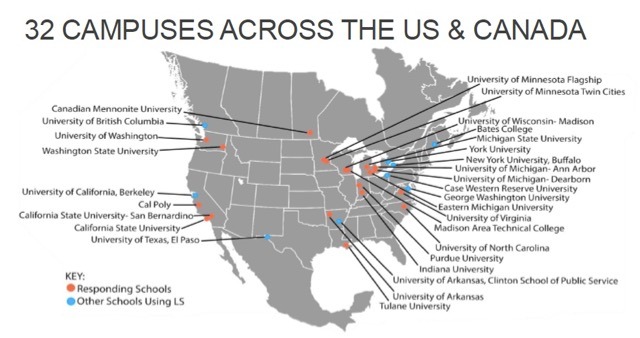 LS spreading across higher education campuses across North America. Source: Darin Harris, U of Wisconsin (Madison)
LS spreading across higher education campuses across North America. Source: Darin Harris, U of Wisconsin (Madison)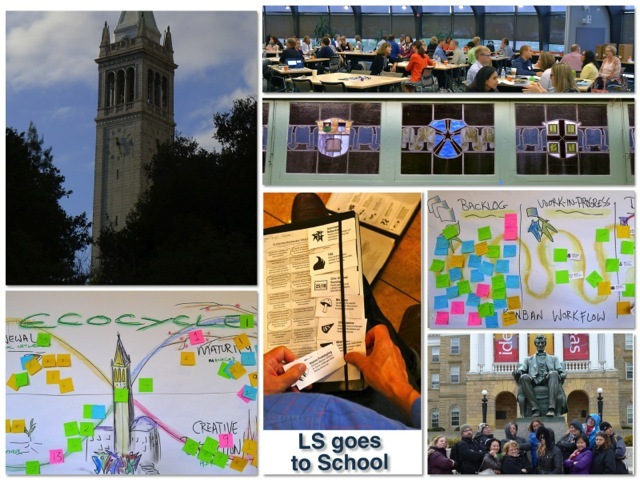 2015 featured immersion workshops at top universities in the US: U of Washington (Seattle), Texas (El Paso), Wisconsin (Madison), Michigan (Ann Arbor), and California (Berkeley & San Luis Obispo).
2015 featured immersion workshops at top universities in the US: U of Washington (Seattle), Texas (El Paso), Wisconsin (Madison), Michigan (Ann Arbor), and California (Berkeley & San Luis Obispo).
NEW: Tools for Engagement by Catherine Lilly. In this business officer magazine, Catherine outlines how LS is making a difference in universities across North America.
In an ideal world all school teachers and college professors would routinely use some Liberating Structures to boost their teaching effectiveness. In the process students would become familiar with them so that, by the time they start working, they would already know how to use many Liberating Structures. There are many reasons that combine to foster such a development, such as communication technologies, the internet and the growth of social networks.
At the same time, the need all over the world for improving educational effectiveness from preschool to graduate school has never been greater. Liberating Structures provide one effective avenue.
By transforming learning into an engaging, interesting and enjoyable activity for both students and professors they increase the learning capacity of all students and the teaching ability of all professors.
Because Liberating Structures are easy to learn and to use they are an inexpensive way to boost the effectiveness of all professors. The combination of technology and Liberating Structures can now free teachers and professors from being stuck in the role of lecturers.
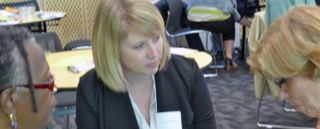 Tatiana Riddle, a “quiet student," fully participating in a Troika Consulting session.Read this open letter from Tatiana Riddle, "From a grateful student to all educators." Tatiana is a quiet student who sees how her voice and all other voices in the classroom can be heard.
Tatiana Riddle, a “quiet student," fully participating in a Troika Consulting session.Read this open letter from Tatiana Riddle, "From a grateful student to all educators." Tatiana is a quiet student who sees how her voice and all other voices in the classroom can be heard.
See how BCCampus educators are matching LS to classroom, faculty development, and administrative challenges.
The need for students to learn how to work with other people before they enter the workforce has also never been greater. Liberating Structures will equip them with a large set of fundamental skills that will increase their ability to perform in any environment, whether as workers, managers or entrepreneurs.
It is well known that engagement is a major factor that affects learning. Consequently teachers/professors – just as all other leaders – have always been challenged to find effective ways of engaging their students. Modern times have greatly exacerbated this challenge. Information/resources on any subject are easily accessible and lectures by prestigious professors are now available at the click of a button.
These great new resources can free up professors from spending most of their time lecturing/transmitting information. Instead they can focus on the more rewarding task of creating more effective learning conditions.
This means a dynamic environment with more time engaged in participative activities, more student-to-student and student-to professor interactions.
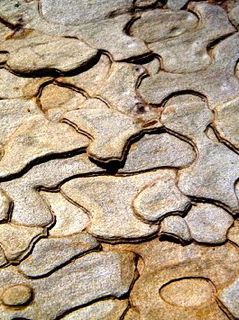 Liberating Structures can help professors accomplish this goal. LS provide a wide variety of structures that they can use like Lego pieces to design lessons for each of their classes. By including all students in interactive learning professors create conditions for self-discovery and peer-to-peer learning, both of which are much more effective than one-way lecturing. Liberating Structures unleash the collective intelligence of the entire community of students. In the process they also help classes develop into communities.
Liberating Structures can help professors accomplish this goal. LS provide a wide variety of structures that they can use like Lego pieces to design lessons for each of their classes. By including all students in interactive learning professors create conditions for self-discovery and peer-to-peer learning, both of which are much more effective than one-way lecturing. Liberating Structures unleash the collective intelligence of the entire community of students. In the process they also help classes develop into communities.
Students will inevitably and effortlessly become familiar with Liberating Structures when a number of their professors start using them routinely in their classroom.
In an ideal world there will be Liberating Structures courses/workshops specifically designed for students to learn and practice many of them. These courses will make “learning to work with others” as essential a skill as reading, writing and math skills and an integral part of every basic curriculum. Indeed, knowing how to collaborate and how to get help from others are the most useful skills that anyone can bring into their work.
What I am describing is already happening albeit on a small scale as described in the attached article by Prof. Arvind Singhal "A Liberated Professor Speaks." Dr, Arvind Signhal, University of Texas, El Paso
Dr, Arvind Signhal, University of Texas, El Paso
When professors start using Liberating Structures both they and their students are invariably thrilled by the results. Classes become enjoyable and students look forward to attend them. To quote one professor, “After 18 years of lecturing, the discovery of Liberating Structures gave me a whole new quality of life by liberating me from routine repetition”
Furthermore many similar experiments are taking place around the country. They are all inspired by the same desire of finding better ways to engage students and to develop teaching methods more effective than lecturing. A recent radio program entitled “Don’t lecture me, rethinking the way American students learn” describes some of the work that is taking place at Harvard, at the University of Maryland, at the University of Washington and at the University of Minnesota.
First academic article on LS! Liberating Structures: Engaging Everyone To Create A Good Life Together. Focuses on LS in higher education and the classroom.
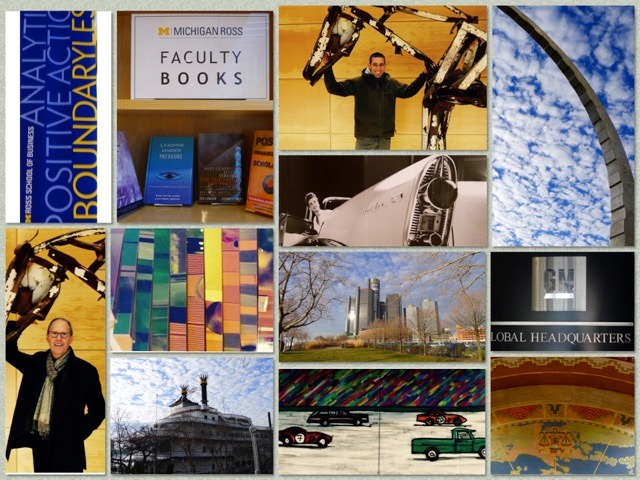 Fisher Qua and Keith McCandless introduced LS @ the U of Michigan Ross School of Business in Ann Arbor and GM in Detroit. As always, LS plays well with existing change efforts. The simplicity and adaptability of microstructures makes adoption a snap.
Fisher Qua and Keith McCandless introduced LS @ the U of Michigan Ross School of Business in Ann Arbor and GM in Detroit. As always, LS plays well with existing change efforts. The simplicity and adaptability of microstructures makes adoption a snap.
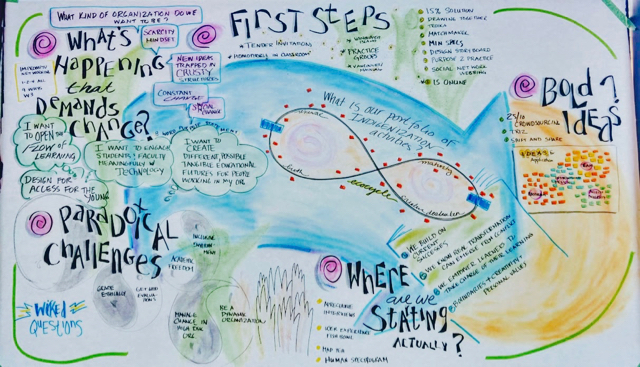 For an immersion workshop in higher eduction, Strategy Gameplan draws out and records the proceedings for a string of LS microstructures (artists Tracy Kelly & Nancy White). What LS do you see in play?
For an immersion workshop in higher eduction, Strategy Gameplan draws out and records the proceedings for a string of LS microstructures (artists Tracy Kelly & Nancy White). What LS do you see in play?
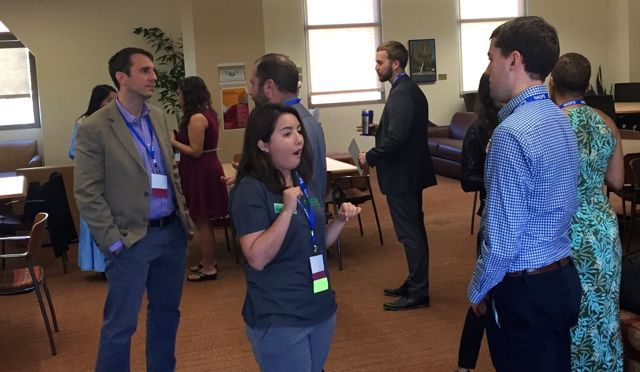
Graduate students are liberated at the National Association of Graduate and Professional Students (NAGPS) Annual Conference at The University of Southern California
Reflections from the first Liberating Structures Fellow--Acadia Roher. PDF It all started at the Clinton School for Public Service in Little Rock, Arkansas.

The following videos, articles and stories illustrate how Liberating Structures are helping to transform education and learning.
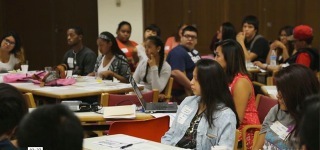 LA Unified School District project
LA Unified School District project
See how Liberating Structures were used by teens in 4-H and the LA Unified School District to promote wellness in their communities. Video The work was sponsored by Molina Healthcare.
More videos:
From Royal Roads University in Victoria, Canada: a series of videos on faculty development and application of LS in higher education.
Creating More Substance, Connections, and Ideas in the Classroom: Liberating Conventional Structures Presentation materials from a 50-minute introduction to LS by Davi Kallman, Laura Hill, and Joe Hewa at Washington State University.
Liberating Structures: Inviting and Unleashing All: Henri Lipmanowicz in Convo with Arvind Singhal
Liberating Classroom: Henri Lipmanowicz in Convo with Arvind Singhal
UnScripted: Liberating Structures by Arvind Singhal
Academic Leadership from the Inside Out Dr. Diane Magrane
A Primordial Pedagogy: Designing the Plexus-Mayo Clinic Summit Keith McCandless
A Liberated Professor Speaks Professor Arvind Singhal
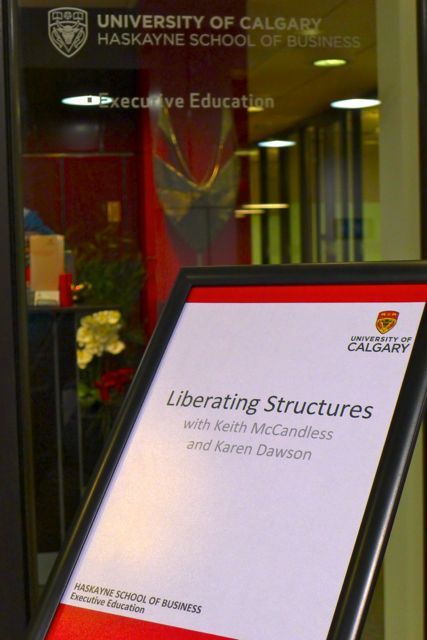 LS session in a business school and executive education setting
LS session in a business school and executive education setting
